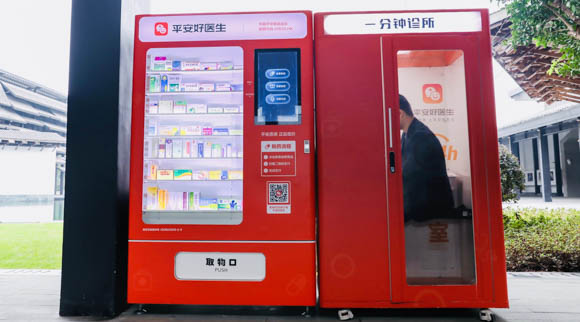Path dependencies and strict regulations set online healthcare back: COVID-19 has thrown it a lifeline
reviving a struggling industry
Online health racked up awesome statistics during the crisis. Ping’an Good Doctor, a leading online app, saw new registrations grow tenfold, average daily visits ninefold through the Spring Festival, with over 1 bn visits overall. For all independent online healthcare apps, peak daily usage approached 7 million.
COVID-19 rescued online healthcare just in time. Intended to end overcrowding in China’s top hospitals, services boomed in the early 2010s. In 2014, US$7 bn was channelled to some 600 companies; at its peak there were as many as 5,000 firms. Since then, the boom has been deflating with over 1,000 firms folding in 2017. State Council’s 2018 directive on ‘internet+ healthcare’ gave the survivors temporary relief, but firms still struggled to turn a profit. In early 2019, Tencent shut down its three-year-old signature online health service, Tengai Doctor, a significant casualty for the industry.
growing policy support
Strict regulation has rolled out far more readily than policy support. Tech firms struggle to carve out a niche in the ever more regulated digital landscape. Large public hospitals monopolise healthcare resources while the NHC (National Health Commission) insists on linking internet services with physical hospitals.
Providers are prohibited by NHC regulations from profiting from scheduling hospital appointments, their most popular online service. Rampant price hikes in appointment reselling were once prevalent. Prescription drug sales are a more recent avenue for potential profit, thanks to the 2019 revision to Drug Administration Law. But public hospitals are fierce defenders of their prescription-writing turf and centralised drug procurement is preventing a price war.
To call themselves online hospitals, private online firms must at a minimum be able to sign on qualified medical practitioners, not least to write prescriptions. If patients see little benefit but increased risk (a concern with online diagnosis), they will revert to already overstretched hospitals.
Support stepped up in H2 2019: guiding principles for BMI (basic medical insurance) to cover online healthcare finally emerged in August 2019. Even so, the advent of COVID-19 was another fillip to the industry. Landmark healthcare insurance legislation enshrined online health services in the future healthcare system. First-time online clinical visits now stand a chance of being insured. A raft of support measures for IT announced 4 February call for more online healthcare and education. Staring survival in the face, the industry must become more competitive as hospitals, rather than collaborate, step up the launch of their own online services.
accessing data
Data remains troublesome. Not only are digital patient histories underdeveloped, but lack of standardisation across hospitals and regions frustrates firms. National Medical Products Administration’s effort to standardise, launched October 2019, solves some issues. Even so, fierce rivalry between hospitals hampers firms from gathering sufficient data. Patient privacy concerns also make hospitals reluctant to share.
Ultimately, data protection has implications for national security. The 2016 Cybersecurity Law and subsequent NHC regulations have urged data protection and foreign entities are banned from collecting and storing biological data. An upcoming Biosecurity Law is expected to outline comprehensive protection measures. Since 2017, central SOEs have been formed to build infrastructure for healthcare big data. The landscape of data collection could be completely reshaped as they take over.
Easing BMI coverage of online healthcare by standardising data remains just a promise. User privacy violations led to many apps being shut down by the National Computer Virus Emergency Response Centre on 10 April, Privacy and data standardisation plague epidemic monitoring software as well.
liberating the force of technology
In a widely circulated interview, Wang Chen 王辰 Chinese Academy of Medical Sciences president emphasised that current success in COVID-19 control come down largely to social mobilisation. To realise its value, health tech must improve vastly, requiring intricately choreographed steps for policymakers, public hospitals and online providers.
Spotlighting cutting-edge health tech (AI will be the subject of a forthcoming signal), COVID-19 exposed many vulnerabilities. The opportunities it provided leave some fundamental issues unresolved. Strictly confined to a fraction of health services, online providers remain dependent on public hospitals, to an extent that limits growth.
The role of tech in the healthcare system has never been fully addressed. To date, regulators have reacted in kneejerk fashion as new technologies emerge. It will be crucial to factor them in, addressing the privacy issues they raise, as healthcare reforms enter a new decade.
what the experts are saying

Liao Jieyuan 廖杰远 | WeDoctor Group founder and CEO
Taking his infant nephew to a dozen hospitals nationwide to treat a rare disease, Liao found use for his IT training to launch an online platform. In 2015 he set up China’s first internet hospital in Wuzhen, Zhejiang. He later helped draft State Council’s 2018 opinions on ‘Internet + healthcare’ based on his Wuzhen experience. WeDoctor launched a global healthcare platform for COVID-19 patients around the world.

Chen Qiulin 陈秋霖 | Chinese Academy of Social Sciences Research Centre for Healthcare Industry Development vice director
Working on healthcare economics and social insurance, Chen directed a study of online healthcare in November 2019, showing its supply and diversity growing steadily. To spur healthy rivalry among providers, he urges patient evaluation. He also advises using blockchain to set up a health record system.
